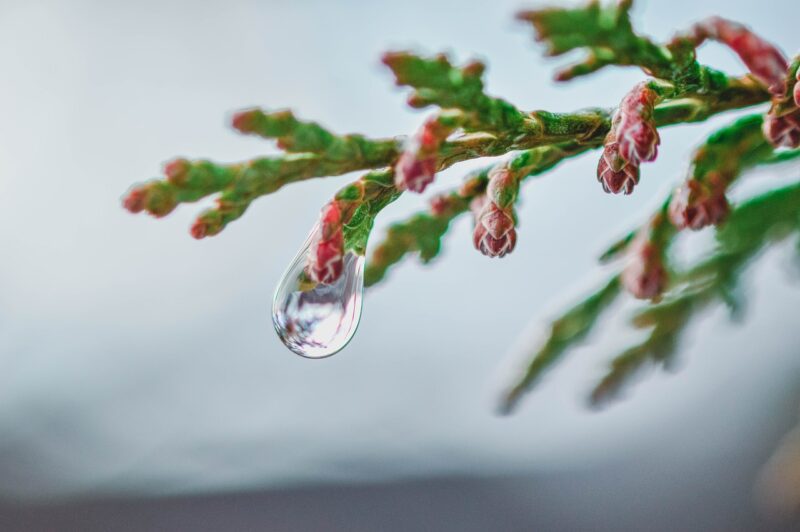The Journey of a Raindrop: From Cloud to Ground and Beyond
November 12, 2024

The lifecycle of a raindrop is not merely a natural phenomenon but a captivating journey that illustrates the beauty and complexity of our planet’s water cycle. Understanding how raindrops are born, travel through the atmosphere, and impact our environment helps us appreciate the significance of water in our lives. This article delves into the fascinating journey of a raindrop, exploring each stage of its transformation from cloud to ground and beyond.
1. The Birth of a Raindrop: Water Vapour and Cloud Formation
The journey of a raindrop begins high in the atmosphere. Water from oceans, lakes, and rivers evaporates due to heat from the sun, transforming into water vapor. This vapor rises, cools, and condenses into tiny water droplets, forming clouds.
Clouds are composed of countless tiny droplets of water or ice crystals that float in the atmosphere. The factors that determine cloud formation include:
- Humidity: The amount of moisture in the air is crucial for cloud formation. High humidity levels enhance the possibility of water vapor condensation and cloud development.
- Temperature: Cool air can hold less moisture, which encourages condensation when warm, humid air rises and cools down.
- Air Pressure: Changes in atmospheric pressure can lead to the rise of humid air, promoting condensation and subsequent cloud formation.
Once clouds collect enough moisture and condensation occurs, the droplets within the cloud begin to collide and coalesce, gradually growing larger. When the raindrops become too heavy for the cloud to hold, they begin their free fall towards the Earth, marking the start of a raindrop’s journey.
2. The Descent: Falling Through the Atmosphere
As raindrops begin to fall from the cloud, several factors influence their descent and behavior during this phase:
- Gravity: The force of gravity pulls the droplets towards the Earth. Depending on their size, raindrops can fall at varying speeds; larger droplets tend to fall faster than smaller ones.
- Air Resistance: Air resistance affects the speed and shape of a raindrop as it descends. Eventually, when the raindrop reaches a certain size, it becomes more spherical to reduce air resistance.
- Wind Currents: Updrafts and downdrafts within the clouds can alter a raindrop’s path, causing it to drift or bounce back up before finally falling to the ground.
Typically, a raindrop can take anywhere from a few seconds to several minutes to reach the ground, traversing through various layers of the atmosphere.
3. Impact with the Ground: A Raindrop’s Final Destination
Upon reaching the earth, a raindrop’s fate can take multiple paths based on the terrain, vegetation, and environmental conditions:
- Infiltration: Many raindrops are absorbed by the soil, replenishing groundwater supplies and supporting plant life. This process is crucial for maintaining ecosystems and providing fresh water for flora and fauna.
- Runoff: If the ground is saturated or impermeable, raindrops contribute to surface runoff, flowing over land and eventually reaching rivers, lakes, and oceans. This process can lead to erosion if not properly managed.
- Evaporation: Some raindrops may quickly evaporate again after contact with warm surfaces, releasing water vapor back into the atmosphere and continuing the cycle.
The interplay of these processes underlines the importance of raindrops as essential contributors to the water cycle, sustaining both the environment and human life.
4. Raindrops in Nature: Their Role and Impact
Raindrops play a significant role in supporting various natural processes, including:
- Nutrient Distribution: When rain falls, it washes nutrients from the atmosphere and soil, redistributing them across the landscape and contributing to soil fertility.
- Regulating Temperature: Rainfall helps cool the temperature of the air and the earth’s surface—an essential function in maintaining a balanced climate.
- Water Supply for Ecosystems: Raindrops are vital for sustaining freshwater ecosystems, which support countless species of plants and animals in aquatic and terrestrial habitats.
Furthermore, raindrops are also a critical resource for agriculture, providing essential irrigation for crops and ensuring food security worldwide.
5. The Journey Continues: From Ground to Sky
After reaching the earth, the story of each raindrop doesn’t end. Instead, many drops contribute to the continuous water cycle:
- Evapotranspiration: Plants release water vapor through a process called transpiration, allowing moisture to return to the atmosphere directly from plant surfaces. Combined with evaporation from soil and water bodies, this continues the cycle.
- Groundwater Recharge: As raindrops soak into the ground, they recharge aquifers, ensuring a steady supply of freshwater for human use and supporting biodiversity.
This remarkable cycle ensures that water maintains its vital role in sustaining life on Earth. Understanding this journey highlights the interconnectedness of nature and the significance of conservation efforts.
Conclusion: Appreciating the Journey of a Raindrop
The journey of a raindrop—from its formation in the clouds, through its descent to Earth, to its impact on the environment and return to the atmosphere—embodies the beauty of nature’s water cycle. This cycle not only supports diverse ecosystems but also provides essential resources for human survival.
By appreciating the journey of a raindrop, we can foster a deeper understanding of the importance of water conservation and promote sustainable practices that safeguard our planet’s vital resources for future generations. The next time you feel a raindrop fall on your skin, remember that you are witnessing nature’s extraordinary cycle in action.







